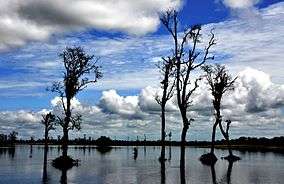Dibru-Saikhowa National Park
| Dibru-Saikhowa National Park Assamese=ডিব্ৰু ছৈখোৱা ৰাষ্ট্ৰীয় উদ্যান | |
|---|---|
|
IUCN category II (national park) | |
 | |
 | |
| Location | Assam, India |
| Nearest city | Tinsukia |
| Coordinates | 27°40′N 95°23′E / 27.667°N 95.383°ECoordinates: 27°40′N 95°23′E / 27.667°N 95.383°E |
| Area | 350 km2 |
| Established | 1999 |
Dibru-Saikhowa (Pron: ˈdɪbru: ˌsaɪˈkəʊwə) National Park is a national wildlife park in Tinsukia, Assam, India.
Dibru-Saikhowa National Park is located at about 12 km north of Tinsukia town of Assam covering an area of 350 km2. It lies between 27°30' N to 27°45' N latitude and 95°10' E to 95°45'E longitude at an average altitude of 118 m (range 110-126 m). It is also a biosphere reserve. The park bounded is by the Brahmaputra and Lohit rivers in the north and Dibru river in the south. It is situated in Dibrugarh and Tinsukia district of Assam. It mainly consists of moist mixed semi-evergreen forests, moist mixed deciduous forests, canebrakes and grasslands. It is the largest salix swamp forest in north east India. Situated in the flood plains of the Brahmaputra and the Lohit, at an altitude of 118 m above sea level, Dibru-Saikhowa is a haven for many endangered species. Due to the auto stocking by the Brahmaputra and Dibru river, it is rich in fish diversity. Dibru Saikhowa has tropical monsoon climate with a hot and wet summer and cool and usually dry winter. The annual rainfall ranges from 2300 mm to 3800 mm. The main rainy months are June, July, August, September. The average coldest and warmest temperature of the area ranges from 7 °C to 34 °C where June, July and August are the hottest while December and January are the coolest months.[1][2]
Conservation
The area was declared as Dibru Reserved Forest in 1890. In 1920, additional area was added to the Dibru Reserve Forest. In 1929, Saikhowa Reserve Forest was declared. In 1933, more area was added to the Dibru RF. In 1986, an area of 650 km2 was preliminarily declared as a wildlife sanctuary out of which finally 340 km2 was declared as wildlife sanctuary in 1995. In 1997, Dibru-Saikhowa Biosphere Reserve was declared with and area of 765 km2 that included the 340 km2 of sanctuary area as the core. In 1999, the 340 km2 of sanctuary area was declared as national park.[3]
Originally created to help conserve the habitat of the rare white-winged wood duck, the park is also home to other rare creatures such as water buffalo, black-breasted parrotbill, tiger and capped langur. The park also has some eco lodges.
Flora
The forest of Dibru-Saikhowa consists of semi-evergreen forests, deciduous, littoral and swamp forests and patches of wet evergreen forests. The national park is about 35.84% moist mixed forest, 9.50% degraded forest and 21.25% grassland. Major tree species of the area are tetrasperma, Dillenia indica, Bischofia javanica, Bombax ceiba, Lagerstroemia parviflora, Terminalia myriocarpa, Mesua ferrea, Dalbergia sissoo, and Ficus. Orchid flora of Dibru-Saikhowa, Arundo donax, Imperata cylindrica, Phragmaties karka, Erianthus ravanea are principal types of grasses in the national park.[4]
Fauna
Mammals Thirty-six species of mammals have been recorded from the Dibru-Saikhowa, of which 12 are listed in the schedule 1 of the Wildlife (Protection) Act of 1972. Species include: royal Bengal tiger, leopard, clouded leopard, jungle cat, sloth bear, dhole, small Indian civet, Malayan giant squirrel, Chinese pangolin, Gangetic dolphin, slow loris, pig tailed macaque, Assamese macaque, rhesus macaque, capped langur, Hoolock gibbon, Asian elephant, wild boar, sambar, hog deer, barking deer, Asiatic water buffalo, and feral horse.
Reptiles Dibru-Saikhowa is rich and diverse in herpetofauna. Two species of monitor lizard, eight species of turtle and eight species of snake have been recorded.
Birds The birds of Dibru-Saikhowa include greater adjutant, lesser adjutant, Indian cormorant, grey heron, purple heron, black-crowned night heron, yellow bittern, Asian openbill, black stork, fulvous whistling-duck, greylag goose, northern pintail, Pallas's fish-eagle, Eurasian griffon, osprey, crested serpent-eagle, spot-billed pelican, white-winged wood duck, Baer's pochard, greater spotted eagle, Bengal florican, pale-capped pigeon, great pied hornbill, marsh babbler, Jerdon's babbler, black-breasted parrotbill, etc.
Travel
The park can be visited by staying at Tinsukia town from where one can catch buses directly.
By air Mohanbari (Dibrugarh) is the nearest airport, which is about 40 km (25 mi). away from Tinsukia.
By rail One of the easiest ways to reach Tinsukia town is by train. One can opt for Rajdhani trains from Delhi city which pass through the route to Dibrugarh.
By road Buses can be taken to the town of Tinsukia which is well connected with Dibrugarh town by NH 37 and the distance is 55 km (34 mi). The distance between the city of Guwahati and Dibru Saikhova National Park will be around 500 kilometres (310 mi) approximately. Travel through the buses can get quite uncomfortable due to improper maintenance and crowds.
See also
References
- ↑ Choudhury, A.U. (1994). A report on bird survey in Dibru–Saikhowa Wildlife Sanctuary, Assam, India. Report to Oriental Bird Club, UK. 71pp+maps.
- ↑ Choudhury, A.U. (1998). Mammals, birds and reptiles of Dibru-Saikhowa Sanctuary, Assam, India. Oryx 32(3):192-200.
- ↑ Choudhury, A.U. (2009). The genesis of a national park. In Incredible Dibru–Saikhowa National Park. Dwivedi, K.K. (ed.). Dibru–Saikhowa Conservation Society, Tinsukia, India. Pp. 6-11.
- ↑ Flora
External links
- Dibru-Saikhowa National Park - Dibru-Saikhowa Conservation Society
- Dibru-Saikhowa National Park - portal

